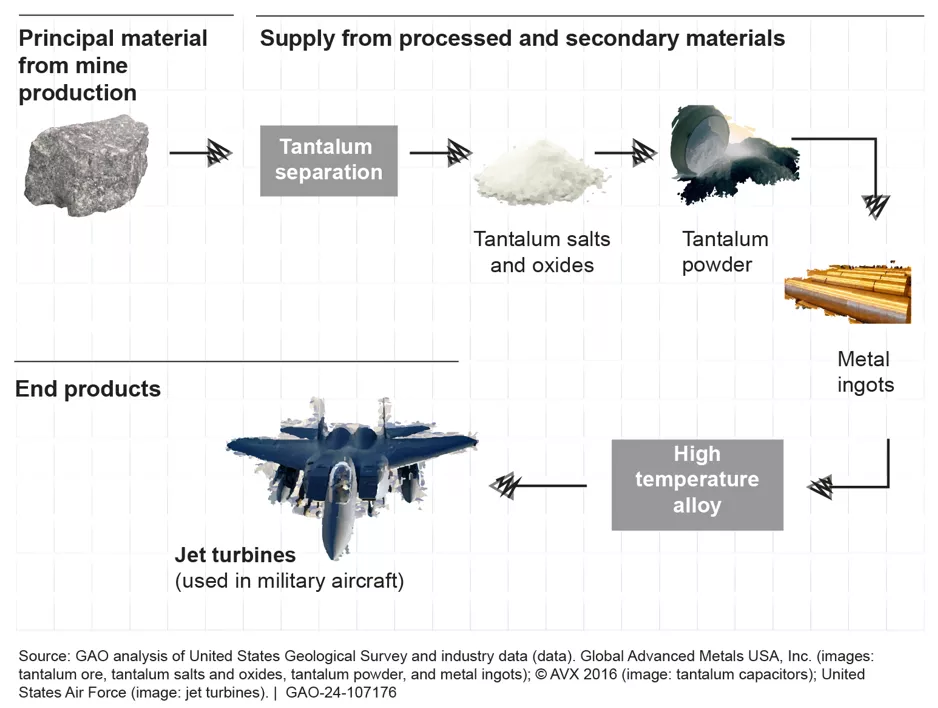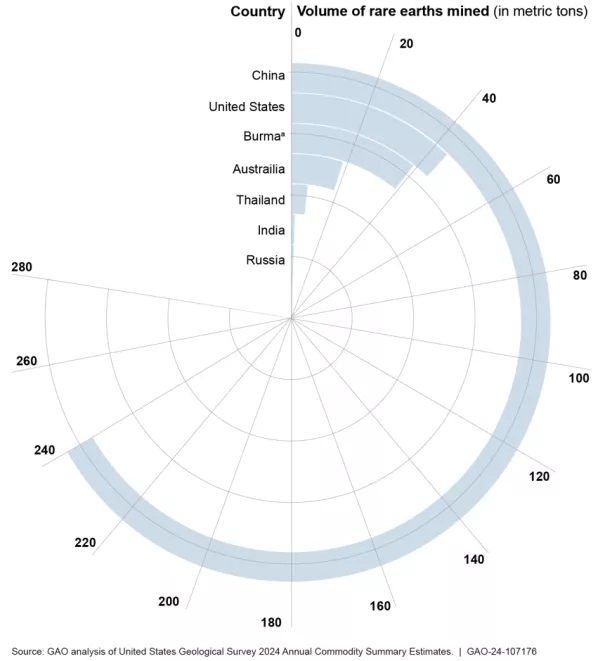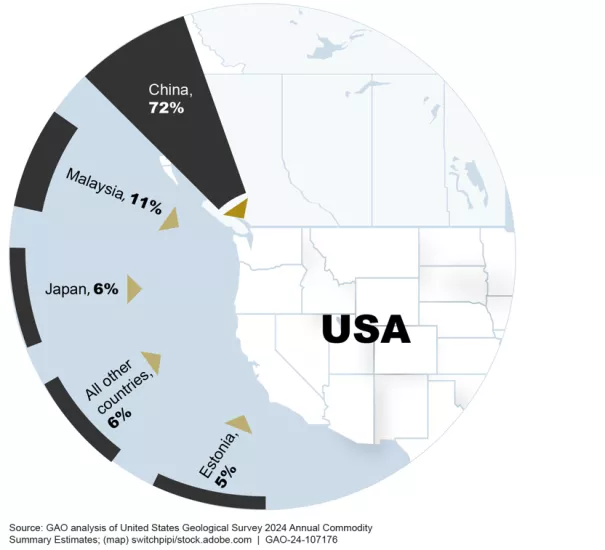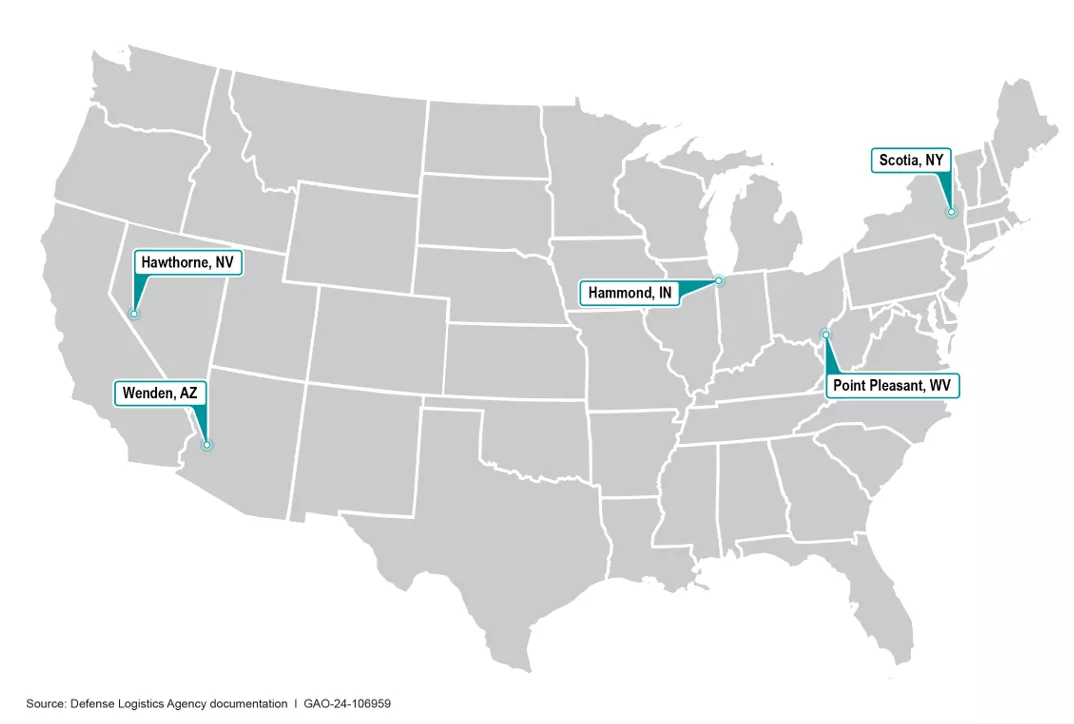Critical Materials Are In High Demand. What is DOD Doing to Secure the Supply Chain and Stockpile These Resources?
Critical materials, such as titanium, tantalum, and tungsten, are key building blocks in many U.S. military weapon systems. They enable unique, high-performance combat capabilities. For example, titanium is a strong, light-weight metal that helps prevent corrosion on weapons used in a variety of climates.
Despite the importance of these materials to our military, in many cases, their sources (for example, mines) are controlled by nations that the U.S. military is in competition with. This puts our national security at risk.
Today’s WatchBlog post looks at our new report about the Department of Defense’s efforts to reduce risks that could affect supply chain access for these materials. We’ll also look at another new report reviewing how DOD maintains a stockpile of these critical materials.
Notional Supply Chain for Tantalum
Image

China controls the supply for many materials critical to our national defense and more
What do smartphones, automobiles, solar panels, and national defense programs have in common? They all depend on critical materials that are not found or produced in sufficient quantities in the United States. The supply chains for these critical materials are spread across the globe. But China dominates the mining and processing of these materials. For example, China mines nearly 70% of the global supply of rare earth elements. Rare earths are critical materials that have unique magnetic and heat-resistance properties that are useful for DOD weapon systems. For instance, a rare earth element called neodymium is used to create magnets that are extremely strong, retain magnetic strength at elevated temperatures, and operate under demanding conditions, such as in combat.
Top Countries Involved in the Mining of Rare Earth Elements, 2023
Image

Why not mine here? In the United States, rare earth mining capacity has waned over the last 40 years. This decrease is due to the emergence of lower-cost suppliers in other nations, such as China, and the significant effect that mining operations pose to the environment. According to DOD officials, the U.S. has more rigorous environmental regulations than China. This allows China to mine and process rare earths and certain other critical materials at a lower cost.
Reliance on China is just one challenge. Between 2019 and 2022, the U.S. imported more than 95% of the total rare earths it consumed. Much of it was from China.
If China decided to no longer sell to the United States, we would lose access to this supply and need to look for alternatives. Unfortunately, the U.S. doesn’t have equivalent substitutes for these materials that perform at the same level. According to the United States Geological Survey, substitutes do not always perform as well and can cost more to produce.
Sources of U.S. Imports of Rare Earth Compounds and Metals, 2019-2022
Image

What is DOD doing to reduce its dependence on China and secure supplies of critical materials?
In our new report, we found that DOD’s ability to influence the market for critical materials is limited. DOD’s demand is relatively low compared to the broader global commercial market for these goods.
With that said, DOD has several efforts underway to reduce its reliance on adversary nations for critical materials. Some of these efforts are required by Congress. Since 2019, Congress has created or expanded several restrictions on DOD’s procurement of critical materials, particularly those that are sourced from China, Iran, North Korea, or Russia. DOD has ongoing efforts to implement these new and revised restrictions from Congress. Learn more by reading our full Q&A report.
DOD’s stockpile of critical materials. DOD also maintains a stockpile of materials that are essential to national defense and civilian life. This National Defense Stockpile includes many of the metals already discussed, such as titanium, and raw materials used to create lithium-ion batteries.
We recently sat down with GAO’s Bill Russell to learn more about how DOD decides what to stockpile and how it manages these resources. Listen to our podcast below.
In our September report we detail DOD’s management of the National Defense Stockpile and some of gaps in these efforts. For example, we found that DOD does not have the appropriate information (data) it needs to project shortfalls for nearly half of materials critical to national security. Similarly, we found that while DOD has guidance for some aspects of managing the stockpile, it has not yet finalized the criteria for releasing materials for use.
We made six recommendations about these issues and others identified in our full report. Learn more by reading that report and listening to our podcast linked above.
Locations of the National Defense Stockpile Materials
Image

- GAO’s fact-based, nonpartisan information helps Congress and federal agencies improve government. The WatchBlog lets us contextualize GAO’s work a little more for the public. Check out more of our posts at GAO.gov/blog.
GAO Contacts
Related Products

GAO's mission is to provide Congress with fact-based, nonpartisan information that can help improve federal government performance and ensure accountability for the benefit of the American people. GAO launched its WatchBlog in January, 2014, as part of its continuing effort to reach its audiences—Congress and the American people—where they are currently looking for information.
The blog format allows GAO to provide a little more context about its work than it can offer on its other social media platforms. Posts will tie GAO work to current events and the news; show how GAO’s work is affecting agencies or legislation; highlight reports, testimonies, and issue areas where GAO does work; and provide information about GAO itself, among other things.
Please send any feedback on GAO's WatchBlog to blog@gao.gov.




